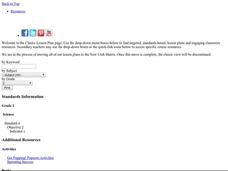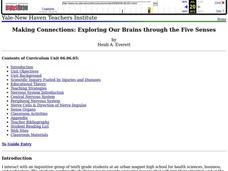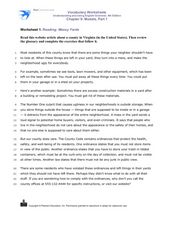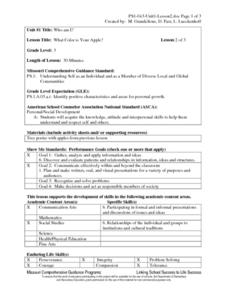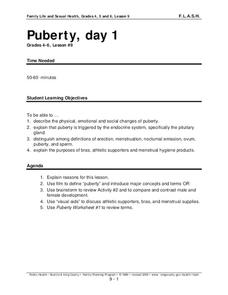Curated OER
Life on the Trails
Fourth graders explore U.S. Geography by completing a worksheet. In this west coast geography lesson plan, 4th graders discuss the Santa Fe and Oregon-California trails and the people who traveled them in the 1800's. Students define...
Curated OER
Vermicomposting
First graders investigate composting. In this biology lesson, 1st graders identify ways to use garbage as fertilizer. Students examine soil and compost matter as well as the role of worms in the dirt.
Curated OER
Fable of the Fainting Goat
Second graders explore animal life by reading children stories in class. In this goat fable lesson, 2nd graders read several books which describe the different myths and folklore about goats. Students identify the needs of living animals...
Curated OER
My Little Seed House
Second graders explore plant life by participating in a germination activity. For this botany lesson, 2nd graders read several books about seed germination including Sunflower House and Tiny Seed. Students identify the necessary elements...
Curated OER
Vermicomposting
Second graders create an eco-bin and study the habitat of the worm in soil. In this vermicomposting lesson plan, 2nd graders observe the effects of water ( too much or too little) and other factors on the eco-bin.
Curated OER
A Day Without Agriculture
Second graders define and create a list of agricultural products. For this producers and consumers lesson, 2nd graders participate in a contest to find as many types of agriculture as they can. The student who comes up with...
Curated OER
Agriculture Pays
Second graders role play one of the jobs related to agriculture and explain their role in getting one of the five "f's" of agriculture to the consumer. In this agriculture lesson, 2nd graders are assigned a role and a...
Curated OER
Agriculture Counts
Young scholars practice counting. In this early numbers lesson, students learn about the beginnings of agriculture and how it ties into math. Young scholars practice counting objects related to agriculture.
Curated OER
Cows, Worms and Compost
Third graders explore agriculture by viewing a PowerPoint presentation in class. In this animal relationship lesson, 3rd graders identify the types of farm animals humans feed on and their dependency on such small insects like worms....
Curated OER
How Much is Dirt Worth?
Fourth graders graph the percentages of the materials that make up the Earth and complete computations based on their results. In this topsoil lesson, 4th graders diagram the different layers of Earth's composition.
Curated OER
Farm to Lunch: Exploring Agricultural Careers
Fourth graders examine Utah's economic structure and learn about agricultural careers. In this agricultural careers lesson, 4th graders follow agricultural products from their source to the lunch table. Students chart their results...
Curated OER
Caring for the Land
Fifth graders examine how to care for the land. For this soil management lesson, 5th graders participate in a service learning project and assist in the preservation of natural resources.
Curated OER
Paint's Family Tree
Learners sort and classify the genetic traits of horses. In this heredity and genetics lesson, students read dialogue in a skit in which specific physical traits of several horses are described and a horse family tree is created....
Curated OER
Now You Have It, Now You Don't
Sixth graders compare corn-based shipping peanuts to Styrofoam shipping peanuts. In this hands-on environmental awareness lesson, 6th graders try dissolving two different types of packing peanuts in water.
Curated OER
Making Connections: Exploring Our Brains through the Five Senses
Students identify structures of the brain, and neurons and analyze their functions. In this nervous system instructional activity students create drawings and models of anatomy.
Curated OER
Reading: Messy Yards
In this reading comprehension worksheet, students read a detailed text about the problem of mess yards in residences in a county in Virginia. Students then answer 6 multiple choice questions about the text.
Curated OER
Risk Taking Behaviors
Tenth graders listen to a presenters introduction and write questions they hope to have answered during the presentation. They listen to a presentation and record notes. They participate in small group discussion and complete...
Curated OER
The Circulatory System - Part I
First graders consider what effect their behavior has on their health. Students make a fist to indicate the size of his/her heart. They complete a worksheet on the heart, coloring the arteries red and the veins blue.
Curated OER
Sexual Exploitation: Day 1: Communication
Learners research and practice communication skills as assertiveness and listening in terms of sexual exploitation. In this communication lesson plan, students practice skills in 2 person teams.
Curated OER
Sexually Transmitted Diseases: Overview
Young scholars observe human heath by completing a worksheet in class. In this STD lesson, students identify the different types of diseases which are spread through sexual intercourse and what symptoms will become noticeable. Young...
Curated OER
What Color Is Your Apple?
Third graders spend time identifying the characteristics they have and ones they would like to develop for their own personal growth. As a class, they brainstorm ways they can tell they are growing up or being mature. Individually, they...
Curated OER
Puberty
Students investigate life science by answering maturity questions. In this human health lesson, students identify the changes which occur during puberty and answer study questions based on sexual awareness. Students define scientific...
Curated OER
Sexual Exploitation: Day 2
Students evaluate human psychology by answering sexual health study questions. In this exploitation lesson, students identify the main causes for sexual assault, the best ways to deal with it at the time and how to prevent it from...
Curated OER
Respecting Differences
Fifth graders brainstorm what a relationship looks like in which both people respect each other. After completing a worksheet, they discuss the importance of respecting other beliefs. To end the lesson plan, they identify things they can...





